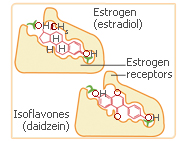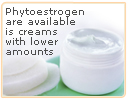Uses of Phytoestrogen Herbs
There are many uses for phytoestrogen supplements in modern medicine. Today more and more people are turning to these naturally-occurring compounds as an alternative to man-made and potentially dangerous hormone replacement treatments. It is important to understand how phytoestrogens work in order to comprehend the different uses of phytoestrogenic herbs.
How Do Phytoestrogenic Herbs Work?
 Phytoestrogen products work by adding the plants� own estrogen-like compounds to the body, helping to balance hormone levels. Phytoestrogen products work by adding the plants� own estrogen-like compounds to the body, helping to balance hormone levels.
Phytoestrogen supplements contain active chemical components such as isoflavones, coumestans, and lignans which work in a very similar way to the estrogen hormone in humans. Herbal phytoestrogens formula binds to receptor sites on human cells and compete with chemical estrogens which may cause the body more harm than good.
There are two possible ways that phytoestrogens work in cells, and they react depending on the estrogen levels present in the body. If estrogen levels are low then the phytoestrogen compounds bind to the site, effectively raising estrogen levels by mimicking the body�s own estrogen compounds. Alternatively, if estrogen levels are high, phytoestrogens block estrogen receptors with their own weaker form of estrogen, effectively lowering estrogen levels.
What are Phytoestrogenic Herbs Used for?
Phytoestrogen supplements have a number of uses which mainly focus on increasing estrogen levels and balancing hormone levels within the body.
Estrogen is commonly known as a female hormone because large amounts of this chemical are found in women and only small amounts in men. Estrogen, along with progesterone, helps to regulate the menstrual cycle and ensure fertility in a woman. For these reasons, problems with the menstrual cycle, fertility, and menopause are all reasons for a phytoestrogen supplement to be used.
Menopause: Menopause can cause a number of uncomfortable side effects and there are a range of treatments available for women during this time. Hormone replacement therapy (HRT) and Estrogen replacement therapy (ERT) can both relieve menopausal symptoms and are recommended for women who are post menopausal. As well as reducing hot flashes and mood swings, both HRT and ERT can also help prevent cardiovascular disease and osteoporosis.
As both treatments include prescription estrogens, many people view them as being unnatural and therefore potentially dangerous. Phytoestrogen supplements are currently being used as a natural alternative and are proving to be extremely popular among menopausal women.
 Osteoporosis: Osteoporosis is a common condition which affects people as they mature and the result is painful and debilitating swelling of the joints. Low estrogen levels are thought to contribute to osteoporosis as post menopausal women often see their bones weaken. Phytoestrogen for osteoporosis can be an effective treatment. Osteoporosis: Osteoporosis is a common condition which affects people as they mature and the result is painful and debilitating swelling of the joints. Low estrogen levels are thought to contribute to osteoporosis as post menopausal women often see their bones weaken. Phytoestrogen for osteoporosis can be an effective treatment.
Phytoestrogen Products
 Small amounts of phytoestrogen appear in many common food sources and there are innumerable ways to include such compounds in the diet. Soy beans, soy products, alfalfa fodder and flaxseed are all food stuffs which can be taken to directly increase the amount of phytoestrogens in the body. Small amounts of phytoestrogen appear in many common food sources and there are innumerable ways to include such compounds in the diet. Soy beans, soy products, alfalfa fodder and flaxseed are all food stuffs which can be taken to directly increase the amount of phytoestrogens in the body.
Some forms of phytoestrogen have been made into specific products which solely help to introduce phytoestrogen into the body. Although phytoestrogen products are more commonly found in capsule or pill form, phytoestrogen cream can also be purchased. Now that the uses of phytoestrogenic herbs have been considered, click the following link to read the next section about phytoestrogenic herbs benefits.
Conclusions
Although many people find phytoestrogens to be largely effective in treating hormone and estrogen-related health problems, a phytoestrogen supplement can also have negative side effects because it introduces foreign compounds into the body. To learn more about alternatives to phytoestrogen for treating menopausal symptoms, click on the article below.
Which herb should women try? Today women are looking for relief from their menopause symptoms with herbs. Phytoestrogenic herbs and non-estrogenic herbs are good in relieving menopause symptoms, but recent studies show that non-estrogenic herbs have no side effects because they help the body to produce its own hormones instead of introducing hormones like the phytoestrogenic ones. Learn more about non-estrogenic herbs for menopause.
| 

